

Youth Justice System • Separate to adult system - Criminal law modified by: • Young Offenders Act (1993) • Family and Community Services Act (1972) • Age of Criminal Responsibility is 10 Years, held to be less criminally responsible • Tiered structure of diversion prior to Court action • Informal Cautions • Formal Cautions • Family Conferences
Key Youth Justice Agencies • South Australian Police • Courts Administration Authority – Family Conferences • Youth Court • Department for Communities and Social Inclusion – Youth Justice • Sector Partners – Health, Education, Housing, Disability, Community Connect
Some stats for SA In SA, on any average day during 2010-11 • 440 young people were under juvenile justice supervision • 85% were under community based supervision (N = 372) • 15% were in detention (N = 70) • Of those in detention, approximately 50% are on remand (For an update of statistics http://www.aihw.gov.au)
General profile of population • Small % of YP continue offending well into adulthood and are responsible for a disproportionate amount of crime during their adolescence. • Early onset moderate offenders often show a peak in offending by 14 years and a decline subsequent to that time. • Late onset (15-16 years onward) moderate offenders comprise a significant percentage of the juvenile justice system populations. • Most children and young people ‘grow out’ of offending and adopt law-abiding lifestyles. (AIC Trends and Issues Paper No. 409 February 2011)
Who are the young people who come into the justice system • Most come from major cities • Overrepresentations of Aboriginal youth • Most come from lower socio economic areas • The higher a young persons socio economic status the less likely they will be held in a detention facility. • Most under supervision are male • Higher rates of mental health, drug and alcohol, behavioural issues than the general youth population. (AIHW 2010/11)
Who are the young people.. • tend to significantly lag behind in educational attainment; this is often related to prior school failure or exclusion and rates of special education disabilities. • tend to have higher rates of experience of past abuse and violence (including familial neglect and violence), and are more likely than the general population to have been a victim of crime in a non familial community setting.
What about young women Young women involved in crime are likely to have: • a history of childhood abuse or neglect • psychological or mental health issues such as mood and anxiety disorders, and • experience of self-harm or attempted suicide • a history of out-of-home care or unstable accommodation • chronic illness or disability
What types of crimes • Certain types of offences – graffiti/vandalism are committed disproportionately by young people • More likely to commit crimes in an opportunistic manner, in public areas and in groups (AIC 2011) • ABS data indicates that the principal offences proceeded by SAPOL for 2011/12 regarding youth were: • Illicit drug offences • Offences against public order
Link between maltreatment & offending • Relational issues • Lack of warmth/control • Rejection • Poor supervision • Harsh discipline • Modelling violence → Poor emotional regulation Behaviour Problems / Mental Health / Abuse / Learning Homelessness OFFENDING Neglect and Peer / Care Problems Impact on brain development in early years and in adolescence and beyond Cashmore (2011) & conference presentation 2012
• Timing matters – onset & duration of maltreatment – Higher risk for later offending when maltreatment starts or continues into adolescence • Transitions – vulnerable periods → into primary school → from primary school into high school → into care
Risk factors for delinquency Child Poor problem solving; Beliefs about aggression; Attributions; Poor social skills; Low self-esteem; Lack of empathy; Alienation; Hyperactivity/disruptive behaviour; Impulsivity; Prematurity; Low birth weight; Disability; Prenatal brain damage; Birth injury; Low intelligence; Difficult temperament; Chronic illness; Insecure attachment Familial Psychiatric disorder, especially depression; Substance abuse; Criminality; Antisocial models; Family violence and disharmony; Marital discord; Disorganised negative interaction/social isolation; Parenting style; Poor supervision and monitoring of the child; Discipline style (harsh or inconsistent); Rejection of the child; Abuse; Lack of warmth and affection; Low involvement in child’s activities; Neglect; Teenage mothers; Single parents; Large family size; Father absence; Long-term parental unemployment. School School failure; Normative beliefs about aggression; Deviant peer group; Bullying; Peer rejection; Poor attachment to school; Inadequate behaviour management Life events Divorce and family break-up; War or natural disasters; Death of a family member. Community and Socio-economic disadvantage; Population density and housing conditions; Urban area; social factors Neighbourhood violence and crime; Cultural norms concerning violence as acceptable response to frustration; Media portrayal of violence; Lack of support services. Adapted from Homel et al. (1999) as cited in Day & Casey (2007) Review of Programs in Youth Training Centres . Report for the Guardian of Children & Young People
Recommend
More recommend